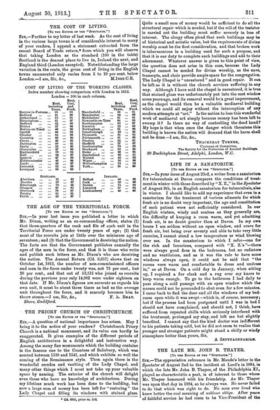• THE PRIORY CHURCH OF CHRISTCHURCH'. [To THE EDITOR OF
THE "STECTATOR."]
SIR,—A question of national importance has arisen. May I bring it to the notice of your readers ? Christchurch Priory Church is a national monument, and its value can hardly be exaggerated. It gives examples of the different periods of English architecture in a delightful and instructive way. Among the many fine monuments which the building contains is the famous one to the Countess of Salisbury, which was erected between 1530 and 1541, and which exhibits so well the coming of the Renaissance style. Then again there is the wonderful reredos and vaulting of the Lady Chapel, and many other things which I must not take up your valuable space by naming. The exterior of the church will delight even those who have no knowledge of architecture. During my lifetime much work has been done to the building, but now a large sum of money has been left for " restoring " the Lady Chapel and filling its windows with stained glass.
• Cd. 6955, price 4s. lld. Quite a small sum of money would be sufficient to do all the structural repair which is needed, but if the will of the testator is carried out the building must suffer severely in loss of interest. The clergy often plead that such buildings may be of historical and artistic value, but the requirements of divine worship must be the first consideration, and that broken work is inharmonious in a building used for such a purpose, and that it is our duty to complete such buildings and add to their adornment. Whatever answer is given to this point of view, the question does not arise in this case, because the Lady Chapel cannot be needed for divine worship, as the nave, transepts, and choir provide ample space for the congregation. The Lady Chapel is "unrestored " and in good repair. It can he left as it is without the church services suffering in any way. Although I have said the chapel is unrestored, it is true that stained glass was unfortunately put into the east window some years ago, and its removal would boa great improvements as the chapel would then be a valuable mediaeval building which we could all enjoy without the interruption of any modern attempts at "art." Is the nation to lose this wonderful work of mediaeval art simply because money has been left to swamp it ? Is there no way of controlling the dead hand? My hope is that when once the danger which threatens this building is known the nation will demand that the harm shall not be done.—I am, Sir, &c.,
THACKERAY TURNER,
Chairman of Committee, The Society for the Protection of Ancient Buildings.
20 Buckingham Street, Adelphi, London, W.C.


































 Previous page
Previous page